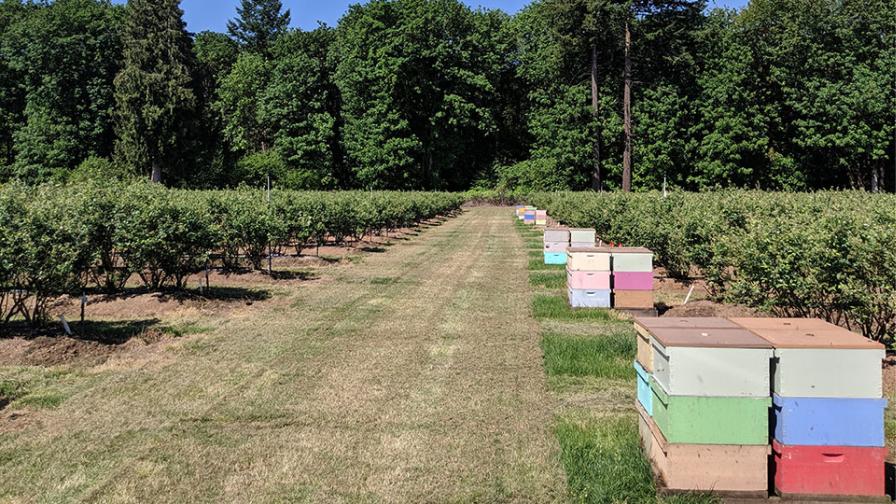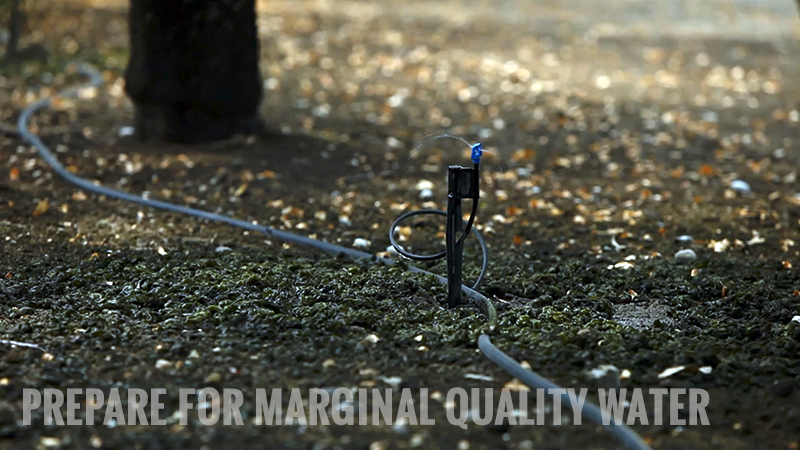The Buzz on Beehive Quality for Better Berries

Bee colonies that are grouped closely together can be serviced more efficiently by beekeepers, and growers can more easily avoid hitting them with spray drift.
Photo by Andony Melathopoulos
Whatever pollination woes a berry grower might be experiencing in the field cannot be solved by simply assembling more beehives.
Instead, hive quality — as well as placement — matters more than quantity, according to Andony Melathopoulos, Assistant Professor of Horticulture, Oregon State University (OSU).
For starters, too many hives may promote the presence of European foulbrood (EFB), a brood disease caused by the bacterium Melissococcus plutonius. In severe cases of EFB, bee colonies are seriously weakened or killed.
“Particularly in blueberries, we’re seeing signs that higher stocking rates may be problematic,” Melathopoulos says. “Beekeepers are getting a little bit wary of increasing their stocking rates for fear that it may bring out these infections.”
What, then, is an ideal hive density? Citing recent research by Matt Arrington, Assistant Professor, Brigham Young University, Melathopoulos says stocking rates in ‘Duke’ blueberry fields can rise as high as eight hives per acre and still show increases in yield and profit.
With such a limit in place, Melathopoulos turned his intent to improving hive quality. He received help from Lisa DeVetter, Assistant Professor of Small Fruits, Washington State University, resulting in a project led by Kennedy Grant, one of his undergrad students at OSU.
LONG-TIME STANDARD
A crop pollination guide designed in 2011 for the state of Oregon had specified a minimum standard of three hives per acre, with each colony inside the hives boasting six frames covered with adult bees and six frames with some brood on the frame.
“A proxy in this guide is that there should be 100 bees per minute returning to the colonies when you’re above 65°F and it’s not that windy,” Melathopoulos says.
One problem: DeVetter, upon visiting 18 fields in 2014 and 2015, discovered that not one was achieving such a return rate.
“That was a little bit concerning — that maybe the colonies coming into blueberry pollination weren’t strong enough,” Melathopoulos says. “The alternate hypothesis was that maybe this 100-bees-per-minute doesn’t indicate a high-quality colony.”
In response, Grant, Melathopoulos, and DeVetter delved into the bees-per-minute return rate. What they discovered was unexpected.
One tested colony, with a return rate of 97 bees per minute, boasted 14 frames of adult bees rather than the minimum standard six frames. Another colony, with a return rate of only 27 bees per minute, still featured almost four frames of adult bees.
Grant spent the next two years examining 84 more colonies. He found that a rate of 100 bees per minute corresponded to 11 frames of adult bees. Meanwhile, the minimum colony strength standard of six frames was achieved via a rate of only 37.5 bees per minute.
In retrospect, many of the 18 fields that had failed DeVetter’s test years earlier had actually been sufficient.
IMPROVED YIELD
Grant (in what is/was her thesis), Melathopoulos, and DeVetter initiated a study involving 25 commercial blueberry fields in the Willamette Valley, each with four colonies per acre. They determined an average flight count after randomly choosing 10% of the videotaped colonies and later factored in fruit set, weight, and count.
“Wouldn’t that be cool,” Melathopoulos says, “if you could drive around and look at the entrance counts and be able to say, ‘These colonies are really great,’ and know that you’re going to get a yield increase.”
To his “delight and astonishment,” Melathopoulos found that incoming flight count corresponded favorably with yield estimate.
“Most of the fields were above that minimum (of six frames of bees), and there seems to be quite a bit of yield increase when you go above that minimum of six frames,” Melathopoulos says. “Our biggest yield came from a colony way on the other end of it, above 100 bees per minute.”
No significant effects were shown by year or cultivar.
“People know there are cultivar differences: ‘Duke’ tends to have less pollination problems than ‘Liberty’,” Melathopoulos says. “But when you get to these really strong colonies, at four colonies an acre, it seems to smooth all of that out. It’s kind of remarkable.”
HIVE PLACEMENT
The inclination to evenly spread hives across a field to get better pollination has some merit. Studies indicate that colonies that are dispersed have somewhat more yield.
However, the increase is not significant, Melathopoulos says. More importantly, he adds, beekeepers can more efficiently service colonies that are grouped, and growers can more easily avoid hitting them with spray drift.
“At least in blueberry, the benefits just in terms of beekeeper relations far outweigh the benefits you get from yield, which seem to us to not be significant,” he says.
NEXT STEPS
Melathopoulos recommends regular discussion meetings among growers, beekeepers, crop consultants, and extension agents. In addition, the OSU Extension website has built an image/video gallery that speaks to hive strength. Finally, the work is now being repeated in Washington, Michigan, and Florida as part of a larger effort to develop a Pollination Planner tool for blueberries, led by Rufus Isaacs at Michigan State University.
Melathopoulos also suggests that growers budget more for beekeeper services. According to a 2016 OSU pollination survey of the Pacific Northwest, the average rental rates for beekeepers were $186 for almonds (117,322 colonies) $56 for cherry (10,677), and $55 for blueberry (8,396).
“Berry pollination, from a beekeeper perspective, is not the biggest pollination market. Most of the beekeepers at this moment are in California, getting compensated really well for that pollination. Most of the other pollination markets are stagnant,” Melathopoulos says. “But I think the opportunity is there. I think there’s a lot of value from stronger colonies, and if you can pay beekeepers just a little bit more for that quality, I believe you’re going to get that back in terms of berry yields.”










